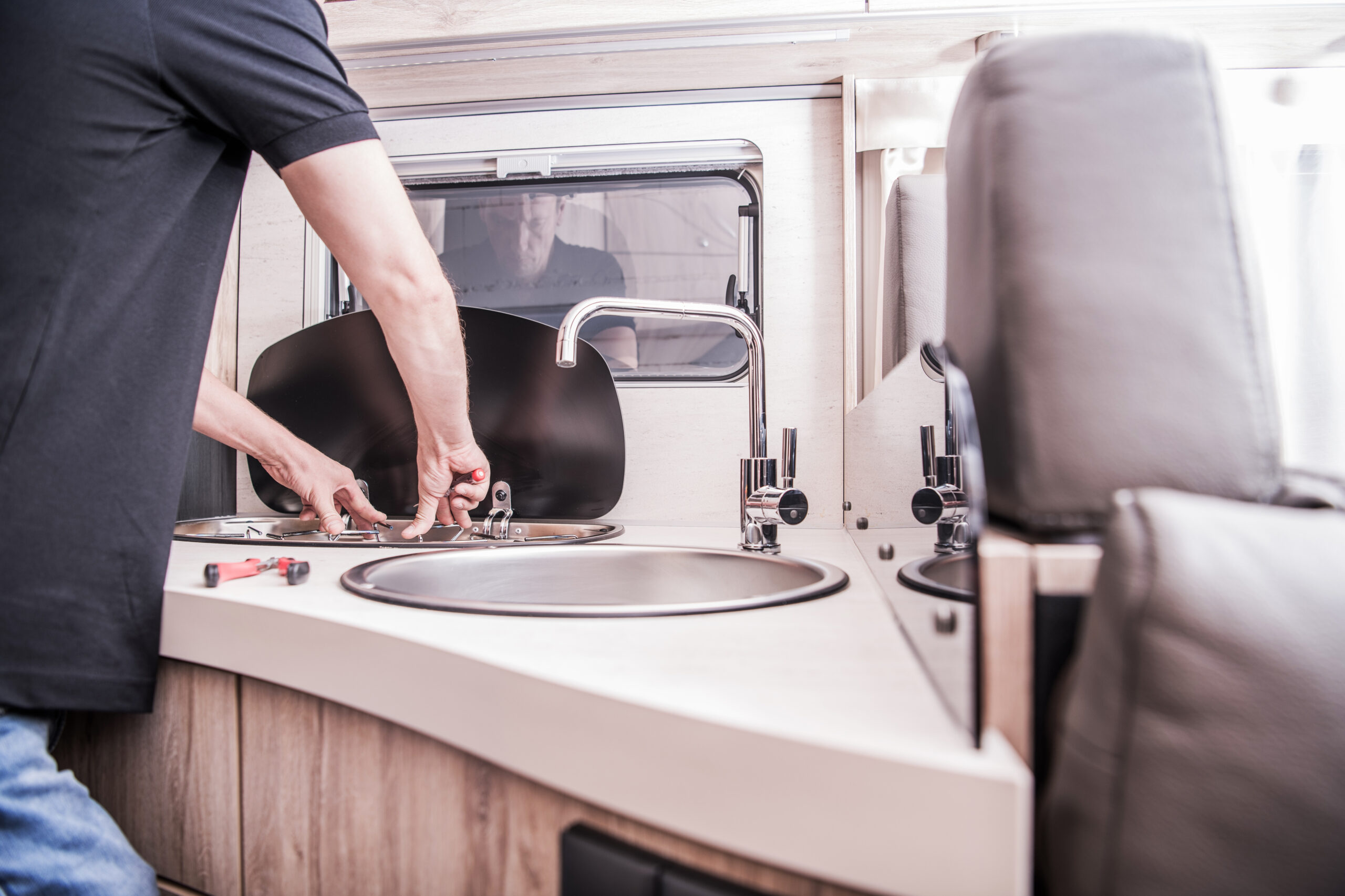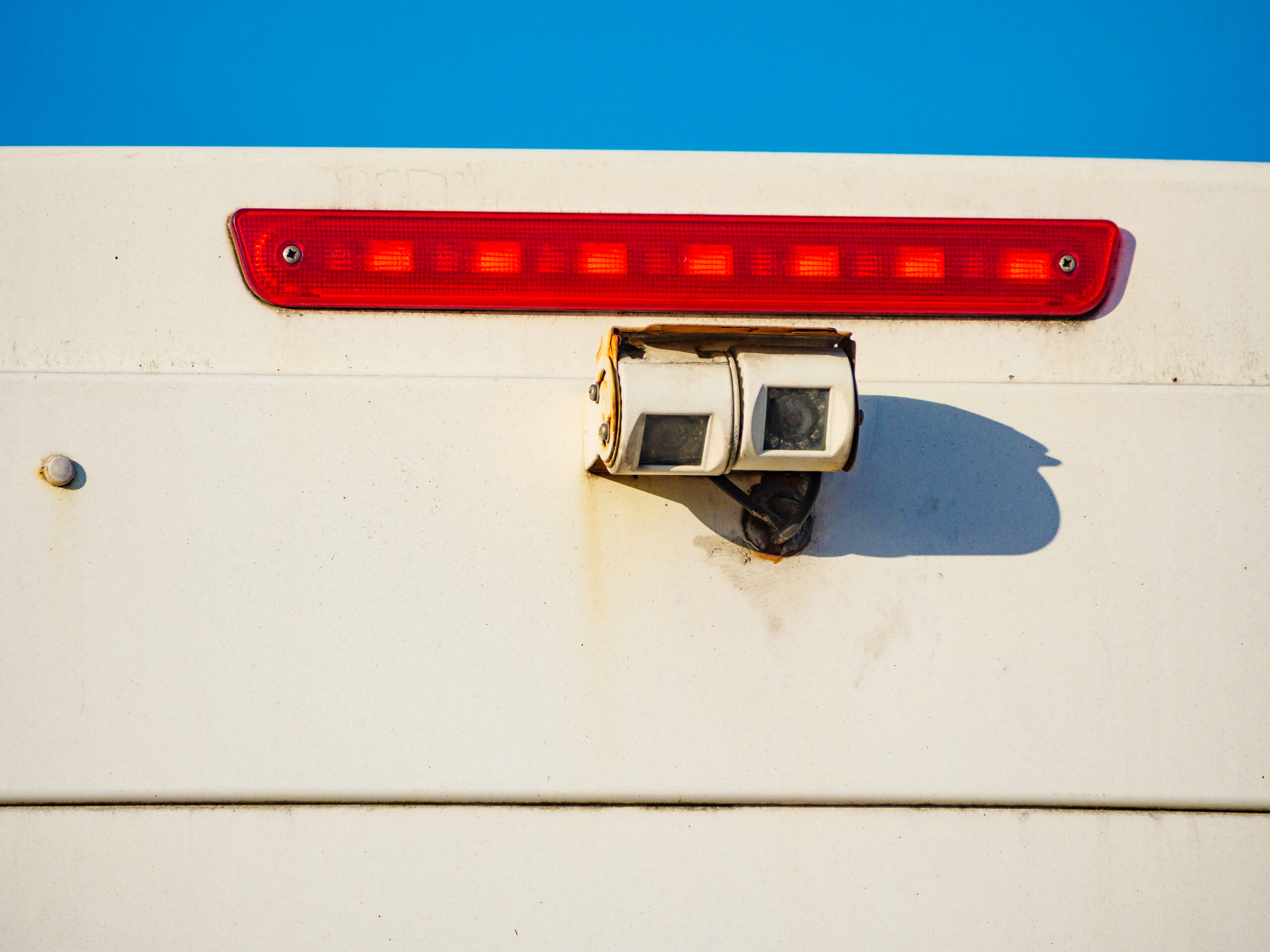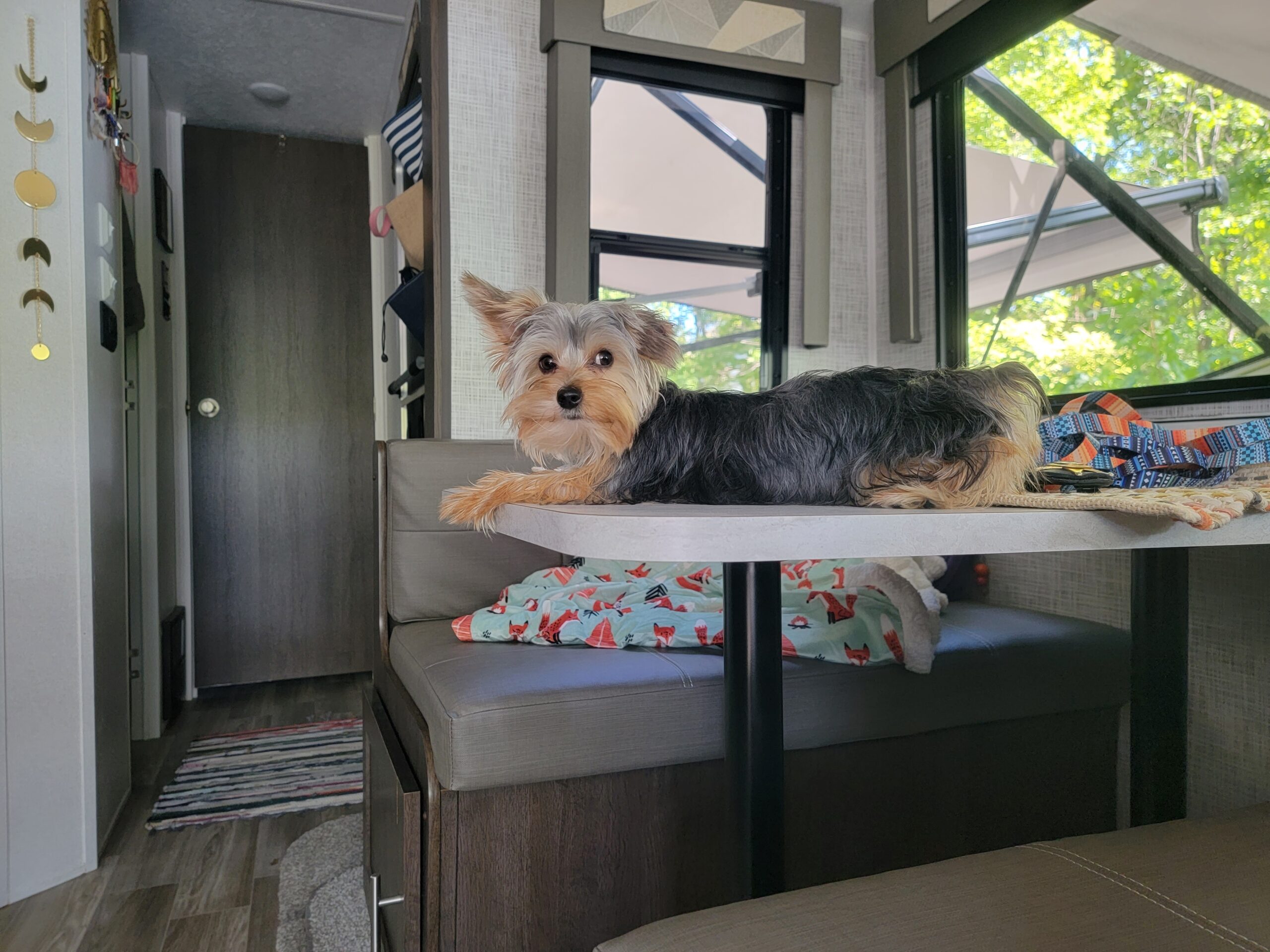
Here’s Where to Upgrade Your RV First
New RVs are coming packed with more and more tech and valuable appliances. But whether your RV is brand new or has some miles under its wheels, there is always room for RV upgrades.
Below are some RV upgrades that every RVer should think about adding to their RV. These RV upgrades will not only make your RV adventures easier and possibly more fun, but some will also make your RV safer.
Faucet/shower RV upgrades
Most RV faucets and showerheads that come standard have two things in common. They use too much water, and many are cheaply made.
If you like to boondock, saving water can be the difference between leaving that fantastic free campsite you found and staying a few more days. Cheap plastic faucets can easily break, and the paint can chip, causing your faucets to look warn out before they should.
Faucet
Installing new and higher quality faucets is relatively easy. It doesn’t have to be an RV faucet either. You can install any residential faucet you want using an adapter to screw the residential faucet hookups to your RV plumbing.
So whether you want the latest and greatest touch faucet with WiFi technology made from pure vibranium in your RV kitchen/bathroom, or you just want something with a little more style, the world is your oyster. The video below shows how easy it is to upgrade an RV faucet.
Water-Saving Aerator
Aerators add air to water coming out of faucets to improve the taste, prevent splashing, and better direct water flow. Some also have built-in restrictors that help conserve water.
For RVers who find themselves camping without hookups, an aerator rated at 0.5 gallons per minute (GPM) can help save a lot of water making them one of the best inexpensive RV upgrades.
The Tri-Max 3 Flow Rate Aerator is an excellent option because it has three flow settings, 0.5 GPM, 1.0 GPM, and 1.5 GPM. The settings are great because you can save water when you need to, but you can also fill a pot of water quickly when you need to. According to their site, the “Patented Flex-Flow™ pressure compensating technology guarantees a consistent flow rate across a wide range of pressure.”
RV Showerhead
Switching out your stock RV showerhead with an Oxygenics one is an easy and inexpensive way to make your RV showers way more enjoyable. Oxygenics has two RV shower handle options, the Oxygenics Body Spa and the Fury Handheld.
Both showerheads mix air into the water stream to increase the pressure, making the notoriously lousy water pressure in many RV parks more usable. They are also low-flow showerheads, so they use less water than the typical RV showerhead.
The Fury Handheld only uses 1.8 gallons per minute at 80psi while the Body Spa uses 2 GPM. Using less water will help if you are camping without hookups, but the other advantage is that the hot water in your water heater will probably last longer. Because of that, this is one of the first RV upgrades many RVers purchase.
RV Suspension Upgrades
Your typical suspension system that comes standard with fifth wheels and travel trailers can do with a few upgrades. Many towable RVs have leaf spring suspension systems and can have quite a bit of bounce and sway.
If the slightest bump in the road or gust of wind causes you to white knuckle the steering wheel, have a look at these towing RV upgrades for a smoother and safer ride.
SumoSprings
If you are looking for a cost-effective, do-it-yourself suspension upgrade for your fifth wheel or travel trailer, SumoSprings should be at the top of your list. They use a micro-cellular urethane material with millions of air pockets to cushion the movement of your leaf springs. They work similarly to airbags, except they don’t require maintenance or compressors to work.
Their design allows them to become progressively harder as more force is applied. So they give you a shock-absorbing stiffer ride when it’s needed and a softer ride when not. This results in a significant reduction in trailer lean and bounce. The shock-absorbing property will minimize vibration as well. This reduces wear on your leaf springs and RV components that are subjected to vibration.
This suspension upgrade is not just for travel trailers and fifth wheels. They were actually available for motorhomes before towable RVs. If you have a diesel pusher with an airbag system, you probably won’t need them. But many gas motorhomes use leaf springs and could definitely benefit from this suspension upgrade.
Check out the video below to see how easy it is to install this RV upgrade.
Whenever you are looking at adding RV upgrades, check out the iRV2.com forum. Use the search feature to find posts about the product you are curious about.
iRV2 is filled with real RVers discussing absolutely everything RV-related. A quick search for this product on the forum shows that SumoSprings get a lot of praise from the RVing community.
Equalizer, Shackles, and Wet Bolts
If your fifth wheel or travel trailer has two wheels on each side, it’s a tandem-axle, and three wheels would be a triple. The triangular metal piece attached by the center bolt is the equalizer. Its job is to equalize the load between tires of tandem and triple-axel rigs.
The two silver metal pieces on either side of the equalizer are the shackles. The bolts holding the shackles are not “wet bolts” because they don’t have grease points.
Many stock equalizers are the bare minimum. Upgrading to an aftermarket equalizer like a MORryde CRE2-33 CRE3000 Suspension System can help put less stress on your suspension system and smooth out the ride giving an overall better towing experience.
As you drive down the road, the shackles have a lot of stress put on them as they are continually being forced back and forth to equalize the load on your leaf springs. This can cause a significant fail point for your suspension system. Fortunately, companies like MORryde also make the MORryde UO12-016 Heavy Duty Shackle Upgrade Kit. The shackle upgrade kit comes with heavy-duty shackles, bronze bushings, and wet bolts. It can greatly enhance your RV suspension system’s safety.
In the video below, you can see the difference an upgraded equalizer makes to your towing experience.
Roadmaster Active Suspension
Improving the suspension of your travel trailer will enhance the performance and handling of the RV itself, but what about your tow vehicle?
Though rated for the load, many RVers find their tow vehicle still sags, constantly bounces, and the stock leaf springs bottom out while towing their RV. A myriad of products upgrade your vehicle’s suspension, but one worth mentioning is the Roadmaster Active Suspension (RAS).
The RAS bolts to the rear half of your vehicle’s back leaf springs to give it strength. Like a muscle, the more force that is applied, the more the RAS works to provide the rear suspension strength to keep it stable and prevent it from bottoming out. Unlike some suspension upgrades, the RAS does not require constant maintenance and setting adjustments.
Steering Stabilizer RV Upgrade
Motorhomes have a tendency to sway a bit at the steering wheel. For smaller motorhomes, a gust of wind can cause you to change lanes without even moving the wheel.
For many RVers, making constant micro corrections can feel like you are struggling to keep the rig on the road. It’s annoying and exhausting.
A steering stabilizer like the Roadmaster RSSA Reflex Stabilizer Unit can help keep your wheels pointed in the forward direction. They also give added control in the event of a tire blowout, wind gusts, and rough roads.
The device is a shock encased by a spring. The spring provides the tension to pull your steering wheel back to the center, and the shock will absorb some of the energy from bumps and sudden movements. If you are looking to make your motorhome driving experience more enjoyable and safe, a steering stabilizer is a good RV upgrade to look into.
RV LED Upgrade
If you have an older RV with the original lighting, replacing the incandescent bulbs should be on the list, and here’s why.
- Less power: LEDs use over 75% less power than non LED RV lights. If you are camping without power hookups, using LEDs means longer battery life.
- Longer life: Many LEDs are rated to last up to 60,000 hours, which is about 30 times longer than incandescent lights.
- Cooler temperatures: Incandescent RV lights can burn really hot. They work by heating the filament to the point that it glows, and 90% of the energy used to make them shine is lost as heat. They require more heat as the bulb ages, causing discoloration and even melting of the light fixture parts. LEDs are much cooler because rather than burning a thin wire until it glows white-hot like incandescent lights, they produce light by electrons’ movement over a diode.
- Just as bright or brighter: LEDs come in various colors, including cool and warm versions of white. They are as bright or brighter than their incandescent counterparts.
As you can see, changing to LED lights is a must for RV upgrades because they are safer, safe power, and last longer. They are more expensive than incandescent lights, but the long life makes up for the cost for many people.
It’s easy to make the switch since they make LED lights that fit most RV light types. Amazon has some excellent prices on LED lights. Also, check out this handy guide if you are looking to Replace Incandescent And Halogen Bulbs With LEDs In Your RV.
RV Upgrades for Entertainment
RVs with TVs come with an antenna to pick up local channels wherever you are. Some RVs even have outside hookups for cable or satellite connections. If the RV park doesn’t have cable, you don’t have a satellite, or the local stations are non-existent, what do you do?
Wouldn’t it be nice to have access to Hulu, Netflix, or other streaming services on your RV TV? Many RV parks have WiFi, and many people now have unlimited data plans on phones and hotspots, so having a SmartTV in your RV just makes sense.
SmartTVs can connect to the internet and have apps like Hulu, Netflix, Disney+, ESPN, and other streaming services. There are two ways to get SmartTV functionality in your RV. The first is to buy a SmartTV. But there is a far more accessible and cheaper way to upgrade your existing RV TV. Get a streaming stick.
Devices like Google Chromecast, Roku, and Amazon Fire TV Stick plug into a TV’s HDMI port and connect to the internet via WiFi. They each have their own interface and work a little different, but the result is the same. They turn your dumb TV into a smart one, giving you access to all the streaming services you know and love.
This is a pretty inexpensive RV upgrade to get with a price tag of around $30 for the basic versions of these devices. Keep in mind that you have to sign up and pay for any streaming services you want to use, but if you already use them at home when you aren’t RVing, why not bring them with you on the road?
Upgrade Your RV AC with a SoftStartRV
One of the many conveniences that RVs afford campers is an air conditioner. In some cases, the AC also has a heat pump feature to heat the RV. With the comfort of an RV air conditioner comes a significant power draw too.
Have you ever been plugged in at an RV park and had a breaker trip the moment your air conditioner came on while something else was already running? Were you ever stuck running one of your two ACs because the park didn’t have 50 amp sites? Do you love boondocking but don’t want to lug around a big 3000-watt generator to run your air conditioner?
If any of the above situations apply to you, then you definitely need a SoftStartRV. Even if you haven’t run into the above problems, you should think about getting a SoftStartRV.
What is a SoftStartRV?
Your RV air conditioner takes advantage of the energy transfer when gas compresses and expands. The refrigerant liquid absorbs heat from the air inside the RV, causing it to evaporate into a gas. The gas then gets a bunch of energy added to it by being compressed by, you guessed it, the compressor.
Now being hotter than the outside air, the gas gets sent through a series of pipes designed to vent off heat. Helped along by a fan, the initial heat the refrigerant picked up from the RV inside gets blown outside while the gas recondenses into liquid.
After taking a trip through an expansion valve to become cool low-pressure liquid again, it’s ready to absorb more heat, and the process starts again. You can get a bit more detail on this, along with how a heat pump works here.
How a SoftStartRV System Works
The compressor has a powerful electric motor, which must be brought up to speed when the unit kicks on. Some ACs can see a momentary spike of around 50 amps or more. That spike is quick, but it’s enough to trip breakers, add wear to the compressor, and prevent you from running more than one AC on 30 amps. It’s also why you need that giant generator to run your AC while boondocking.
The SoftStartRV is an electronic device that controls your air conditioner compressor’s starting amps by smoothly ramping up the voltage. By smartly controlling the startup of the compressor, you gain a few advantages.
- There’s no more thumping sound when your AC starts up. You still hear the fan, but the loud thump that can be heard when the compressor kicks on doesn’t happen.
- Startup amps are reduced by over 50%. That means an AC that used to require a 3000-watt generator will now only need a small Honda 2200-Watt generator to run. For those with two ACs, you can use them both while plugged into a 30 amp outlet.
- The lack of a large current draw is better for all electronic components involved, which could mean a longer life for your RV AC.
Installing SoftStartRV
Though it sounds like a complicated electrical install, it is surprisingly DIY-friendly. There are only five wires that must be spliced or attached to the air conditioning unit on your roof.
The website offers many instructional videos for various brands of ACs, and their customer service will walk you through step by step on the phone if you need them to. Check out their site to order one or to learn more.
I’m a full time RVer, and SoftStartRV gave me a unit to install on my own RV about 7 months ago. The video below details my installation and honest review.
Final thoughts
The RV upgrades listed in this article are not an exhaustive list of RV upgrades. But they are some important ones that all RVers should think about. They can enhance their RV adventures and make them a little safer.
Extra tip: if you want to upgrade your RV trip planning game, too, check out RV LIFE Trip Wizard to plan RV safe routes, find RV parks, gas stops, points of interest, and more. It integrates with the RV LIFE app to turn your phone or tablet into an RV-friendly GPS, offering you turn-by-turn directions.



